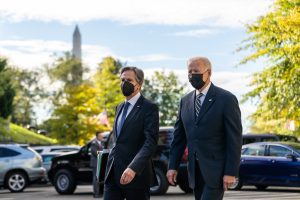After years on the sidelines in Asia, the Biden administration hopes its new Indo-Pacific Economic Framework (IPEF) will get the United States back in the economic game. But while partners in the region welcome a U.S. return to the economic field, they remain skeptical of the benefits of joining Team IPEF. For the Biden administration to win over regional partners, it must address questions and concerns.
Ever since the United States withdrew from the Trans-Pacific Partnership (TPP) five years ago, Indo-Pacific partners have called for an affirmative U.S. economic strategy for the region. Last October, President Joe Biden answered that call by proposing “a new Indo-Pacific economic framework.” Unlike a traditional trade agreement, the IPEF is envisioned as a platform for negotiations on a variety of economic issues arranged in four pillars: fair and resilient trade; supply chain resiliency; infrastructure, clean energy, and decarbonization; and tax and anti-corruption.
Over the past three months, we have interviewed government representatives from over a dozen Indo-Pacific countries, speaking for a variety of developed and developing countries from East, Southeast, and South Asia, as well as Oceania. Several key themes emerged during our conversations.
First, governments in the Indo-Pacific welcome the IPEF. They see it as a symbol of renewed U.S. economic engagement in the region after several years on the sidelines. Although many countries in the region would prefer that the United States rejoin TPP or its successor deal, the Comprehensive and Progressive Agreement for Trans-Pacific Partnership (CPTPP), they still support the IPEF as a standalone initiative.
Second, Indo-Pacific partners want the IPEF to be as inclusive as possible. To regional partners, the success of the IPEF hinges on whether the United States can attract developing countries from Southeast Asia, South Asia, and the Pacific — particularly major economies such as Indonesia, Vietnam, Thailand, and India.
Third, regional partners seek greater clarity on what the IPEF is, what it seeks to do, and how it will be negotiated. The unclear form and function of the framework raise serious questions for prospective participants. The lack of early, two-way communication between the U.S. government and regional representatives has left several countries feeling that their perspectives are not valued.
Fourth, regional governments see the IPEF as a proposal with many U.S. requests, few U.S. offers, and many credible alternatives. In a typical trade agreement, the attraction of greater access to the U.S. market counterbalances politically challenging U.S. requests for higher labor, environmental, and other standards. The Biden administration has repeatedly stated that U.S. market access incentives are off the table. Without this, regional partners see few tangible benefits for them, particularly when compared to new alternatives like the Chinese-led Regional Comprehensive Economic Partnership (RCEP) and Belt and Road Initiative (BRI).
Finally, regional governments are concerned about the IPEF’s staying power given the volatility of domestic politics around trade in the United States. Regional governments also seek sustained senior White House support for the IPEF initiative.
These concerns about the overall contours of the framework were reflected in views of each of the IPEF’s four pillars. The trade pillar, seen by many as a laundry list of U.S. trade policy requests, was the most difficult for regional partners to digest. Its important digital subcomponent drew mixed reviews from advanced and developing partners. Potentially attractive U.S. offers in the supply chain and infrastructure pillars were tempered by a lack of information and expectations of U.S. demands for high standards. The tax and anti-corruption pillar was the least clear, and least attractive, to regional partners.
None of these concerns is insurmountable, and the need for affirmative U.S. economic engagement in the Indo-Pacific remains pressing. The IPEF is a good first step by the Biden administration toward meeting this regional need. If U.S. policymakers can address questions and critiques from Indo-Pacific governments related to form, function, benefits, inclusivity, and durability of the framework, then the IPEF has a real chance at securing buy-in from the region. This is turn is essential to advancing U.S. economic and strategic interests in the world’s most dynamic region.
Addressing regional concerns will be difficult, take time, and require U.S. policymakers to be responsive to requests from regional partners. But failure of the IPEF is not an option. U.S. strategic and economic success in the Indo-Pacific, as well as the mutual prosperity of all regional partners involved, will be worth the effort of building consensus behind this framework.
This article highlights research from a recent CSIS paper by the co-authors.

































